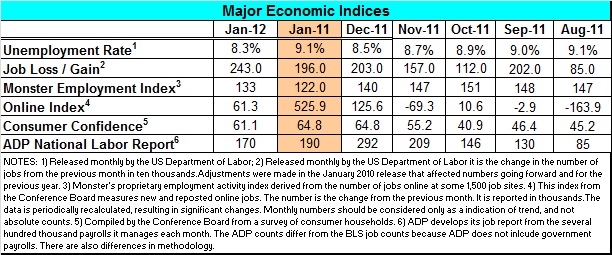Strike up the band. Break out the confetti. The market’s going to love this. The U.S. unemployment rate dropped to 8.3 percent and non-farm jobs grew by 243,000 in January.
This morning’s monthly report from the U.S. Department of Labor blasted through even the most optimistic of expectations. The jobs gain would have been the largest since May 2010, except that the Labor Department’s data group adjusted 2011?s jobs numbers. Now, only March (+246,000) and April (+251,000) had stronger numbers.
January is the second consecutive month to beat estimates. Economists predicted anywhere from MarketWatch’s tepid 121,000 to the more optimistic 182,000 in the Bloomberg survey. None of the widely reported surveys saw a decline in the unemployment rate.
Lowest unemployment rate since Feb. 2009
Indeed, the unemployment rate, which has been declining very slowly since hitting a peak of 10.1 percent in late 2009, is now at the lowest point since February 2009. The government report also put the number of unemployed at 12.8 million. A year ago it was at 13.9 million.
While governments continued to cut jobs — federal jobs were cut by 6,000 and local government cut 11,000 positions — the private sector added 257,000. This was more than 50 percent higher than the ADP estimate earlier in the week.
 Most sectors added jobs. Manufacturing accounted for 50,000 new jobs. The services sector as a whole added 176,000 workers, with much of the gain coming in what the government calls “professional and business services.” This includes temp workers and employment services (+33,200) and accounting and bookkeeping services (+12,500), likely due to ramping up for tax season.
Most sectors added jobs. Manufacturing accounted for 50,000 new jobs. The services sector as a whole added 176,000 workers, with much of the gain coming in what the government calls “professional and business services.” This includes temp workers and employment services (+33,200) and accounting and bookkeeping services (+12,500), likely due to ramping up for tax season.
Health care, a consistent growth area, was up by 30,900 positions. Leisure and hospitality, another growth area for several months, was up by 44,000. Even the battered construction industry managed to add 21,000 jobs during the month.
Only finance (off by 5,000 jobs) and the Information sector (-13,000) lost workers. The latter sector includes far more worker categories than computer professionals and data processing, although these areas also lost workers. The bulk of the loss — 7,900 — came in the motion picture and recording industry.
Positive revisions for previous months as well
On top of the strong January numbers, the revisions by the U.S. Bureau of Labor Statistics resulted in improving the overall hiring numbers for 2011 and further. For November and December alone, the BLS revisions showed 60,000 more jobs than initially reported.
Finally, the government said average hourly wages for all non-farm workers rose 4 cents during the month to $23.29. While the average workweek for all workers was unchanged in January, the manufacturing workweek increased by .3 hours to 40.9 and overtime increased to 3.4 hours.
The overall report was so strongly welcomed it sent stock futures soaring before the market opening. The Dow Jones Industrial average futures jumped 95 points.
One cautionary note: The Monster Employment Index, which tracks jobs posted on career sites and job boards, including Monster, has been declining since October. For January, the Index stood at 133, down from October’s 151. The Conference Board, which also tracks online job postings, showed an increase in January, as it did in December. But the total online listings are still not as high as they were in April last year.
